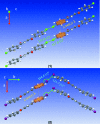Synthesis and crystal structures of (2 E)-1,4-bis-(4-chloro-phen-yl)but-2-ene-1,4-dione and (2 E)-1,4-bis-(4-bromo-phen-yl)but-2-ene-1,4-dione
- PMID: 29765722
- PMCID: PMC5947802
- DOI: 10.1107/S205698901800230X
Synthesis and crystal structures of (2 E)-1,4-bis-(4-chloro-phen-yl)but-2-ene-1,4-dione and (2 E)-1,4-bis-(4-bromo-phen-yl)but-2-ene-1,4-dione
Abstract
The mol-ecular structure of (2E)-1,4-bis-(4-chloro-phen-yl)but-2-ene-1,4-dione [C16H10Cl2O2, (1)] is composed of two p-chlorophenyl rings, each bonded on opposite ends to a near planar 1,4-trans enedione moiety [-C(=O)-CH=CH-(C=O)-] [r.m.s. deviation = 0.003 (1) Å]. (2E)-1,4-Bis(4-bromo-phen-yl)but-2-ene-1,4-dione [C16H10Br2O2, (2)] has a similar structure to (1), but with two p-bromophenyl rings and a less planar enedione group [r.m.s. deviation = 0.011 (1) Å]. Both mol-ecules sit on a center of inversion, thus Z' = 0.5. The dihedral angles between the ring and the enedione group are 16.61 (8) and 15.58 (11)° for (1) and (2), respectively. In the crystal, mol-ecules of (1) exhibit C-Cl⋯Cl type I inter-actions, whereas mol-ecules of (2) present C-Br⋯Br type II inter-actions. van der Waals-type inter-actions contribute to the packing of both mol-ecules, and the packing reveals face-to-face ring stacking with similar inter-planar distances of approximately 3.53 Å.
Keywords: 1,4-enedione moiety; NMR; bis-halo-enedione; crystal structure; synthesis.
Figures





 + y,
+ y,  − z; (v) −x,
− z; (v) −x,  + y,
+ y,  − z] and trifurcated interactions involving the O1 atoms.
− z] and trifurcated interactions involving the O1 atoms.Similar articles
-
(Z)-2,3-Di-chloro-1,4-bis-(4-chloro-phen-yl)but-2-ene-1,4-dione.Acta Crystallogr Sect E Struct Rep Online. 2014 Jul 11;70(Pt 8):o861-2. doi: 10.1107/S1600536814015463. eCollection 2014 Aug 1. Acta Crystallogr Sect E Struct Rep Online. 2014. PMID: 25249911 Free PMC article.
-
Crystal structure of (Z)-2,3-di-chloro-1,4-bis-(4-meth-oxy-phen-yl)but-2-ene-1,4-dione.Acta Crystallogr Sect E Struct Rep Online. 2014 Aug 23;70(Pt 9):o1049-50. doi: 10.1107/S1600536814018790. eCollection 2014 Sep 1. Acta Crystallogr Sect E Struct Rep Online. 2014. PMID: 25309219 Free PMC article.
-
Crystal structure of 2-(4-chloro-phen-yl)-2-oxoethyl 3-bromo-benzoate.Acta Crystallogr Sect E Struct Rep Online. 2014 Oct 8;70(Pt 11):301-4. doi: 10.1107/S1600536814021643. eCollection 2014 Nov 1. Acta Crystallogr Sect E Struct Rep Online. 2014. PMID: 25484728 Free PMC article.
-
Crystal structures of 2,3-bis-(thio-phen-2-yl)pyrido[2,3-b]pyrazine and 7-bromo-2,3-bis-(thio-phen-2-yl)pyrido[2,3-b]pyrazine.Acta Crystallogr E Crystallogr Commun. 2019 Jan 1;75(Pt 1):89-93. doi: 10.1107/S2056989018016882. eCollection 2019 Jan 1. Acta Crystallogr E Crystallogr Commun. 2019. PMID: 30713741 Free PMC article.
-
Bis[1,2-bis-(4-chloro-phen-yl)-ethyl-ene-1,2-dithiol-ato(1-)]nickel(II).IUCrdata. 2022 Feb 17;7(Pt 2):x220148. doi: 10.1107/S2414314622001481. eCollection 2022 Feb. IUCrdata. 2022. PMID: 36340872 Free PMC article.
Cited by
-
Prediction study of structural, electronic and optical properties of 4C16H10Br2O2 Bis (m-bromobenzoyl) methane crystals.Biochem Biophys Rep. 2023 Dec 5;37:101601. doi: 10.1016/j.bbrep.2023.101601. eCollection 2024 Mar. Biochem Biophys Rep. 2023. PMID: 38146351 Free PMC article.
References
-
- Alvarez, S. (2013). Dalton Trans. 42, 8617–8636. - PubMed
-
- Connolly, J. D. & Hill, R. A. (2010). Nat. Prod. Rep. 27, 79–132. - PubMed
-
- Deng, C., Yang, Y., Gao, M., Zhu, Y.-P., Wu, A.-X., Ma, J.-R. & Yin, G.-D. (2012). Tetrahedron, 68, 3828–3834.
-
- Desiraju, G. R. & Parthasarathy, R. (1989). J. Am. Chem. Soc. 111, 8725–8726.
LinkOut - more resources
Full Text Sources
Other Literature Sources
Molecular Biology Databases
Miscellaneous
